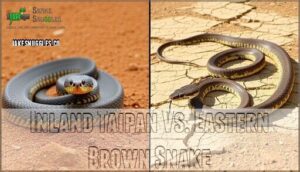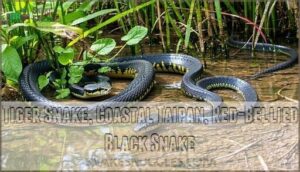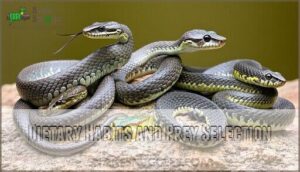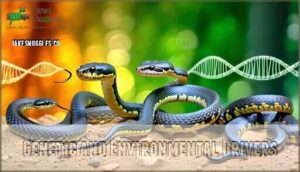This site is supported by our readers. We may earn a commission, at no cost to you, if you purchase through links.
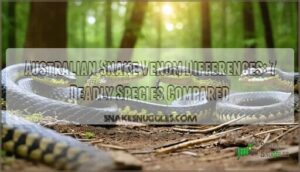
You’ll encounter neurotoxic venoms that paralyze muscles by blocking nerve signals, myotoxic compounds that destroy tissue and trigger kidney failure, and coagulotoxic agents that disrupt blood clotting within minutes.
The Inland Taipan’s myotoxic arsenal causes rapid muscle breakdown, while Eastern Brown Snakes deploy coagulotoxins that turn blood into a clotting disaster.
Geographic location drives these variations – the same species shows different venom compositions across Australia’s ecosystems.
Understanding these Australian snake venom differences isn’t academic curiosity; it’s life-saving knowledge that determines which antivenom works when seconds count.
Table Of Contents
- Key Takeaways
- Key Types of Australian Snake Venom
- Venom Differences Among Australian Snake Species
- Factors Influencing Snake Venom Variation
- Clinical Impact of Venom Variability
- Research and Advances in Venom Science
- Frequently Asked Questions (FAQs)
- How can you tell if an Australian snake is venomous?
- What is the number 1 deadliest snake in Australia?
- Which inland Australian snake is the most venomous?
- Which snake venom is the strongest?
- How long can snake venom remain potent after extraction?
- Can Australian snakes become immune to their venom?
- Does snake venom potency change with snake age?
- How do temperature changes affect venom composition?
- Can snake venom properties vary within same species?
- How long does snake venom remain active after death?
- Conclusion
Key Takeaways
- You’ll encounter five distinct venom types that attack different body systems – neurotoxic venoms paralyze muscles, myotoxic compounds destroy tissue, coagulotoxic agents disrupt blood clotting, while cytotoxic and hemotoxic venoms damage cells and blood vessels
- You can’t rely on standardized treatments because the same snake species produces dramatically different venoms across Australia’s regions – Eastern Brown Snakes in northern Queensland create fragile blood clots while southern populations form strong, stable clots like taipans
- You’ll face varying symptoms and treatment challenges since geographic location, diet, and evolutionary pressures shape each snake’s venom profile – this variation affects how well antivenoms work and determines which medical protocols you’ll need
- You should treat all snake encounters as potentially deadly because current antivenom effectiveness suffers from these geographic variations, and proper species identification during emergencies remains difficult even for medical professionals
Key Types of Australian Snake Venom
Australian snakes inject five distinct venom types that attack different body systems, each requiring specific medical responses.
You’ll encounter neurotoxic venoms that paralyze muscles, myotoxic compounds that destroy tissue, coagulotoxic toxins that disrupt blood clotting, and cytotoxic or hemotoxic venoms that damage cells and blood vessels.
Neurotoxic Venom and Its Effects
When neurotoxic venom enters your bloodstream, it targets nerve signals like a sophisticated saboteur.
Australia’s venomous snakes deliver death through chemical warfare, each species wielding its own deadly cocktail
Australian snake venom from species like the eastern brown snake disrupts communication between nerves and muscles, leading to progressive paralysis that can prove fatal without immediate treatment.
- Nerve Damage: Neurotoxin effects block acetylcholine receptors, preventing muscle activation
- Muscle Paralysis: Progressive weakness starts at bite site, spreads to respiratory muscles
- Respiratory Failure: Diaphragm paralysis occurs as venom potency overwhelms breathing control
- Venom Variation: Snake venom effects differ between populations, affecting treatment outcomes
Myotoxic Venom and Muscle Damage
Damaging muscle tissue becomes your biggest concern when myotoxic venom enters your system. Australian snake venom containing these toxins breaks down muscle fibers, causing severe muscle damage and releasing proteins into your bloodstream.
You’ll notice dark urine as damaged muscle releases myoglobin, potentially leading to kidney failure. Understanding the neurotoxic effects, such as those from rattlesnake venom, is essential for effective treatment and prevention of long-term damage.
| Myotoxic Effect | Timeline | Severity Level |
|---|---|---|
| Initial muscle pain | 1-4 hours | Moderate |
| Muscle necrosis onset | 6-12 hours | Severe |
| Myoglobin release | 12-24 hours | Critical |
| Kidney complications | 24-48 hours | Life-threatening |
| Recovery potential | Weeks-months | Variable |
Treatment outcomes improve dramatically when you receive antivenom quickly, preventing extensive muscle necrosis and reducing envenomation risk from these potent Australian snake venoms.
Coagulotoxic Venom and Blood Clotting
Coagulotoxic venom disrupts your blood’s natural clotting ability, creating life-threatening bleeding or dangerous clot formation.
Pseudonaja textilis (Eastern Brown Snake) demonstrates significant venom variance between populations, affecting coagulation disorders differently.
Thromboelastography reveals distinct clot formation patterns:
- Southern populations create strong, stable blood clots
- Northern variants produce rapid but fragile clots
- Anticoagulant therapy responses vary by geographic origin.
Understanding venom toxicity levels helps medical teams choose appropriate treatments for coagulation disorders.
Cytotoxic and Hemotoxic Venom Properties
Cytotoxic venom destroys cells at the bite site, creating intense pain, swelling, and tissue necrosis.
You’ll experience blistering and potential systemic failure as cell damage spreads.
Hemotoxic venom targets your circulatory system, disrupting blood coagulation and causing internal bleeding.
Snake venom composition varies among venomous snakes Australia-wide, with venom toxicity levels affecting treatment urgency and outcomes substantially, due to the intense pain.
Venom Differences Among Australian Snake Species
You’ll discover that Australia’s deadliest snakes produce remarkably different venoms, even within the same species.
Geographic location, diet, and evolutionary pressures create distinct venom profiles that directly impact how bites affect victims and respond to treatment.
Inland Taipan Vs. Eastern Brown Snake
When you compare Inland Taipan venom to Australian brown snakes, you’re looking at two deadly champions with distinct killing strategies.
The Inland Taipan’s venom biochemistry creates rapid muscle breakdown through powerful myotoxins, while Eastern Brown Snake venom disrupts blood clotting within minutes.
Geographic venom differences show Taipan habitat isolation produces consistent toxicity levels, whereas brown snake populations vary regionally in their venom genetics and snake bite severity.
Understanding the unique characteristics of Taipan Venom is essential for developing effective antivenom treatments.
Tiger Snake, Coastal Taipan, Red-Bellied Black Snake
Tiger snakes dominate wetland habitats across southern Australia, delivering potent neurotoxic and coagulotoxic venom that causes rapid paralysis.
Coastal taipans pack the continent’s second-deadliest bite, combining neurotoxic effects with fierce aggression.
Red-bellied black snakes prefer waterside environments, producing milder myotoxic venom with less fatal outcomes.
These australian snake species showcase distinct venom composition patterns, influencing bite prevention strategies and conservation efforts across diverse ecosystems.
Geographic Variation in Venom Composition
You’ll find Australian snake venom composition changes dramatically across geographic regions.
Australia’s diverse landscapes create dramatically different snake venoms within the same species
Eastern brown snakes demonstrate this perfectly – southern populations produce taipan-like venom forming strong blood clots, while northern Queensland snakes create fragile, rapid clots.
Geographic toxicity patterns reflect evolutionary adaptation, with venom diversity driven by regional prey availability and environmental pressures affecting venom genetics, illustrating regional prey availability.
Factors Influencing Snake Venom Variation
You’ll discover that snake venom composition isn’t random but shaped by three key evolutionary forces.
Geographic location, dietary preferences, and genetic drift work together to create the deadly cocktails that make each species uniquely dangerous, influenced by evolutionary forces.
Geographic Location and Evolution
Australia’s eastern brown snake populations showcase remarkable venom adaptation across geographic boundaries.
Evolutionary pressures have created distinct genetic divides between northern and southern populations, with climate effects driving these changes over millennia.
- Northern Queensland populations: Produce fast-forming but fragile blood clots
- Southern populations (NSW, Victoria): Generate strong, stable clotting compounds similar to taipans
- Geographic variation: Reflects millions of years of localized evolutionary adaptation
Dietary Habits and Prey Selection
You’ll discover that dietary adaptation drives venom evolution substantially.
Specialist feeders like inland taipans consuming mammals develop potent neurotoxic venoms, while generalist snakes eating diverse prey maintain complex venom profiles.
Prey preference shapes hunting strategies – reptile-targeting species show elevated neurotoxicity, whereas broad-diet snakes sacrifice efficiency for versatility.
This diet influence creates distinct venom variability patterns across species.
The study of venom evolution mechanisms further supports the idea that diet plays a vital role in shaping venom composition.
Genetic and Environmental Drivers
Multiple genetic mutations drive venom evolution across Australia’s diverse environments.
Geographic adaptation shapes how snakes develop distinct venom profiles based on local prey and climate conditions.
Venom complexity reflects this intricate interplay.
- Genetic Variation: DNA changes create new venom compounds through evolutionary pressure
- Environmental Factors: Temperature, humidity, and habitat influence venom protein expression patterns
- Dietary Influence: Prey availability triggers genetic switches that modify venom composition over generations
Clinical Impact of Venom Variability
When you’re bitten by an Australian venomous snake, the specific venom type determines your symptoms and how quickly they develop.
The variation in venom composition between species—and even within the same species from different regions—directly affects how well standard antivenoms work and which first aid methods you should use.
Symptoms and Severity of Envenomation
Recognizing envenomation symptoms helps determine treatment urgency and snake venom potency.
Different venom types produce distinct clinical effects, from immediate local reactions to delayed systemic effects that can emerge hours after the bite.
| Venom Type | Early Symptoms (0-2 hours) | Delayed Symptoms (2-24 hours) |
|---|---|---|
| Neurotoxic | Drooping eyelids, slurred speech | Breathing difficulty, paralysis |
| Coagulotoxic | Minor bleeding, bruising | Severe bleeding, blood clotting disorders |
| Myotoxic | Muscle pain, weakness | Dark urine, kidney damage |
| Cytotoxic | Intense pain, swelling | Tissue death, blistering |
Severity factors include venom volume injected, bite location, and individual patient response.
Australian venom differences mean eastern brown snake bites may cause rapid coagulation problems, while taipan envenomation typically produces neurological symptoms first.
Understanding neurotoxic venom’s effects is essential for proper diagnosis and treatment.
Challenges in Antivenom Effectiveness
Understanding symptoms is only half the battle when facing Australian venomous snakes Australia. Antivenom efficacy faces significant hurdles due to venom differences between regional populations. Current antivenom development struggles to match snake venom potency variations, creating gaps in treatment outcomes.
Medical response challenges include:
- Venom resistance varies by geographic snake populations, reducing standardized antivenom effectiveness
- Polyvalent antivenoms may require multiple doses due to incomplete venom differences coverage
- Snake bite management becomes complicated when species identification proves difficult in emergencies
- Regional snake venom potency variations can overwhelm existing antivenom formulations
- Treatment outcomes suffer when antivenoms don’t match specific population venom profiles
Implications for First Aid and Treatment
Snake venom variation creates complex challenges for Emergency Response teams and Treatment Protocols.
When you’re bitten, medical professionals can’t predict which venom toxins you’ve encountered without proper Venom Testing.
This uncertainty affects Antivenom Efficacy decisions, as current antivenoms may not neutralize all geographic variants effectively.
Toxicology research shows that standardized protocols often fall short, leading to unpredictable Medical Outcomes and delayed treatment responses.
Understanding the neurotoxic effects requires knowledge of rattlesnake venom to improve treatment strategies.
Research and Advances in Venom Science
Australian researchers are transforming venom science through integrative studies that examine how snake venoms vary across species and geographic regions.
You’ll find that these advances are leading to more effective antivenoms and improved medical protocols that could save lives in future snakebite emergencies.
Integrative Venom Research in Australia
Leveraging cutting-edge technology, Australian scientists use high-throughput LC-MS and bioinformatics to revolutionize snake venom research.
The Australian Venom Research Unit leads integrative science approaches that create extensive venom databases for medical protocols.
- Advanced analytical pipelines expedite investigation of venom variation across venomous snakes Australia
- Molecular initiatives generate high-quality data infrastructure profiling toxin families
- Research funding supports evolutionary modeling informing snake behavior studies
The study of snake venom variability is vital for understanding the complex composition of venom from different species.
Improving Antivenom and Medical Response
Advances in clinical toxicology reveal how venom variation impacts antivenom efficacy across Australia’s snake populations.
Current antivenom production uses mixed geographic sources, creating gaps in treatment outcomes for specific regions. Emergency response protocols now emphasize rapid snake bite first aid while researchers develop targeted therapies.
Medical protocols must adapt to procoagulant venoms and snake venom genetics discoveries for improved patient care. The development of effective antivenom relies on understanding antivenom kit components and their applications in clinical settings, which is crucial for patient care.
Conservation and Public Health Perspectives
Wildlife Conservation efforts increasingly recognize that protecting venomous snakes in Australia requires balancing Human Safety with preserving Snake Habitats.
Public Awareness campaigns educate communities about Australian wildlife dangers while promoting coexistence.
Environmental Impact studies examine how habitat loss affects snake venom types and delivery mechanisms.
Conservation programs monitor snake populations, supporting research into venom extraction methods that benefit both medical advancement and species protection through sustainable practices.
Frequently Asked Questions (FAQs)
How can you tell if an Australian snake is venomous?
You can’t reliably identify venomous Australian snakes by appearance alone.
All Australian snakes should be treated as potentially dangerous since many venomous species lack obvious warning signs like bright colors or distinctive patterns found elsewhere.
What is the number 1 deadliest snake in Australia?
Death lurks in Australia’s wilderness—the inland taipan reigns supreme.
You’re facing the world’s most venomous snake, delivering enough toxin to kill 100 adults with one bite.
This desert ghost strikes with lethal precision.
Which inland Australian snake is the most venomous?
You’ll find the inland taipan (Oxyuranus microlepidotus) holds the crown as Australia’s most venomous snake. Its venom is incredibly potent, capable of killing multiple adult humans with a single bite.
Which snake venom is the strongest?
You’ll find the inland taipan produces the most potent venom based on toxicity tests, though eastern brown snakes cause more human fatalities due to aggressive behavior and habitat overlap.
How long can snake venom remain potent after extraction?
Like wine aging in a cellar, extracted snake venom maintains its lethal potency for years when properly stored.
You’ll find freeze-dried venom samples retain toxicity for decades at -20°C, while liquid venom degrades within months at room temperature, highlighting the importance of proper storage to preserve toxicity.
Can Australian snakes become immune to their venom?
Yes, Australian snakes develop immunity to their own venom through specialized proteins that bind and neutralize toxic components. You’ll find this evolutionary adaptation prevents self-poisoning during venom production and storage.
Does snake venom potency change with snake age?
Snake venom potency typically increases with age as juvenile snakes develop more concentrated venom proteins and enhanced delivery mechanisms.
You’ll find adult snakes generally produce more toxic venom than their younger counterparts, which can be related to the fact that snake venom potency typically increases with age.
How do temperature changes affect venom composition?
Temperature fluctuations don’t substantially alter venom composition in most snake species.
You’ll find that venom proteins remain stable across seasonal temperature changes, though extreme heat or cold can denature some components, potentially reducing toxicity levels.
Can snake venom properties vary within same species?
Absolutely, you’ll find venom composition varies dramatically within species based on geographic location, diet, and genetic factors.
Eastern brown snakes in northern Australia produce different venom than southern populations, affecting treatment effectiveness.
How long does snake venom remain active after death?
Dead snakes bite, inject venom, kill victims hours later. You’ll face active venom for six to eight hours post-mortem. Decapitated heads retain lethal reflexes, fangs strike reflexively when touched.
Conclusion
Understanding australian snake venom differences empowers you with critical knowledge for survival and medical intervention.
You’ve discovered how neurotoxic compounds paralyze nervous systems, myotoxic proteins destroy muscle tissue, and coagulotoxic agents disrupt blood clotting mechanisms.
You’ve learned that geographic location, dietary patterns, and evolutionary pressures shape these venomous profiles across species.
This scientific understanding enables proper antivenom selection, improves first aid responses, and supports ongoing research initiatives that enhance public health outcomes throughout Australia’s diverse ecosystems.
- https://www.sciencedirect.com/science/article/pii/S1535947620317047
- https://pmc.ncbi.nlm.nih.gov/articles/PMC9917609/
- https://pubmed.ncbi.nlm.nih.gov/16374664/
- https://findanexpert.unimelb.edu.au/news/5744-like-alchemists-with-killer-precision--brown-snakes-make-different-venoms-across-their-lifetime
- https://livingwithwildlife.com.au/australian-snakes/

